© 2026 ALLCITY Network Inc.
All rights reserved.

The Colorado Avalanche hit the All-Star break on a disappointing note with a 3-2 shootout loss to the Arizona Coyotes but find themselves near the top of the NHL and leading the Central Division by a comfortable margin so it wasn’t all bad.
Now that there are a few days in between games, it seemed like as good a time as any to take a look at some of the areas of the Avalanche that have been working and the areas that need some improvement.
Let’s start with the good.
The Good
I want to start this section off by saying that there is significantly more good than anything else and I’ll try to avoid the obvious like Cale Makar and Nathan MacKinnon having elite seasons. Those are elite players; having elite seasons is just what they do.
Nazem Kadri
Aha! I told you I was avoiding the obvious and then I started with the most obvious positive outcome of the entire Avalanche season. The agreed-upon MVP of the Avalanche so far (at least by the DNVR Avs crew), Kadri is having the contract year to end all contract years.
Slightly underpaid for much of his career at just a $4.5M AAV, Kadri is set to hit free agency this summer at age 31. Usually that’s a touch older than most players who are looking to cash in big when they hit the open market but Kadri’s unbelievable season is going to force somebody’s hand.
With 60 points in just 41 games, Kadri is off to his first All-Star weekend just one point shy of his career-high in points in a single season. With just 19 goals (his career-high is 32), it has been Kadri’s playmaking that has driven his explosion of points. Before this year, he had only hit the 30-assist plateau once (in 2013-14 when he was just 23-years-old). He currently has 41.
Assists can be a funny thing when players find their way to a lot of secondary assists, which in the stats community are considered “noise” and unreliable because they have not shown an ability to be repeatable. This makes first assists much more valuable.
Looking at Kadri’s 41 assists, he is third in the NHL with 25 assists at all strengths. If you filter it down to 5v5 to remove the players who get bloated offensive totals from being power-play superstars, Kadri actually moves up to second in the NHL with 18. In fact, Kadri only has five secondary assists at 5v5 this year.
What’s maybe most remarkable about Kadri’s offensive success this year is that his totals aren’t being driven by any obvious statistical outlier. He’s shooting 13.5%, which for many players would be very high, but if the season ended today would only be Kadri’s sixth-best shooting season.
Hell, even Colorado’s shooting percentage as a team with Kadri on the ice at 12.99% is certainly a little high but it isn’t some astronomical number that isn’t to be believed and is a clear candidate for a major regression.
Another aspect of Kadri’s game that has been notable throughout his career is his noted lack of discipline. Setting aside the playoff suspension conversation that everyone is familiar with, Kadri has always been a magnet for referees.
Kadri remains one of the league’s premier players in terms of drawing penalties (he’s fourth in the NHL with 24), he’s only been called for 13 minors this year. That might still be too many for most players, but he’s made a career out of giving back what he gained across a full season. That increased discipline has helped the Avalanche draw more penalties than they’ve taken as a team.
To finish off this section about Kadri, you can see that his isolated impacts haven’t even drastically changed much. I’ve included last year’s so you can compare last year, a notable down year, to the fantastic season he’s having right now.


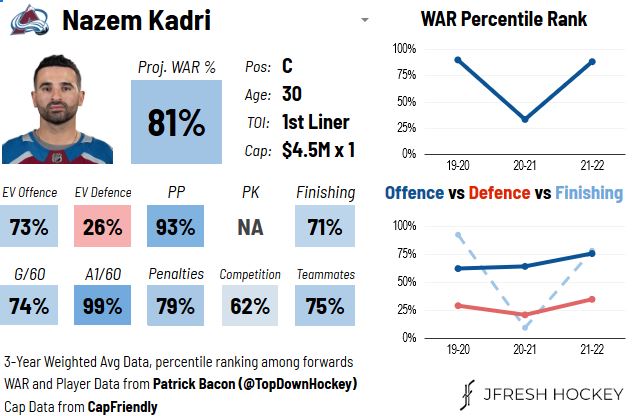
While there are slight upticks in his offense and defense, the biggest difference is in the finishing, and as I mentioned above, it’s not to the kind of degree that sets off any red flags.
The reality here is that Nazem Kadri has been Colorado’s best, most consistent player to this point in the season and he’s a huge reason they have gone 10-2-1 in the games Nathan MacKinnon has missed.
Alex Newhook
Leave it to me to find a reason to praise a rookie, I know. At least you know what you’re getting with me, right?
What we didn’t know coming into this season was what the Avs were getting with Newhook. His preseason was just okay and then his play on opening night left plenty to be desired. For salary cap and development reasons, Newhook was sent back to the AHL to try to get his confidence up with the Colorado Eagles.
In having conversations with some of the people around the organization, Newhook took his demotion like an absolute pro. Instead of feeling like the team had done him a disservice (it happens sometimes with highly-drafted players who haven’t experienced many failures in their lives), Newhook went to Loveland with a mindset dedicated to working hard and earning his way back to the NHL.
After registering 11 points in 10 games with the Eagles, Newhook was recalled. You never know what the future holds, but I feel reasonably confident that he won’t be returning to the AHL.
Since returning, Newhook has 16 points (10 G, 6 A) in 33 games. Considering he is only averaging 13:34 of ice time, it’s very solid production from anyone, let alone a rookie.
Why do I have Newhook on this list? Because he ties the entire lineup together. The fourth line has largely been Tyson Jost and a rotating cast of characters just not doing very much most nights and Colorado’s top six has been popping off with four players above a point-per-game and two others, Val Nichushkin and Andre Burakovsky, on pace to obliterate their previous career-best seasons.
Newhook manning the 3C job for the Avs has been a key to Colorado’s lineup continuing to produce at a high level despite injuries and the usual highs and lows of role players.
Unlike Kadri, Newhook has a very high shooting percentage (19.2%) that says a goalless drought might be coming at some point. What has been encouraging, however, is that Newhook’s production is largely coming at even strength, with just four of his 16 points coming on the power play.
Where I’ve legitimately come to love Newhook’s game, however, is not on the offensive side of the ice. We’ve seen him as an electric scorer his entire career, from the BCHL to NCAA and most recently in the AHL. He can score. He’s always scored. He’s going to continue to score.
On draft day back in 2019, however, the big conversation between Newhook and Peyton Krebs, the center taken one pick after Newhook and rumored to have been the next player on Colorado’s draft board, centered on the maturity and advanced defensive profile from Krebs.
While Krebs is now in Buffalo after being the centerpiece of the Jack Eichel trade, Newhook has quietly put in serious work on his defense. He was a mainstay on Boston College’s penalty kill in both of his college seasons and is starting to get looks on the Avalanche PK now (more on that later).
Newhook’s box score production has justified his role as Colorado’s 3C, but his defensive impact is what is keeping him there and even giving him more opportunities.

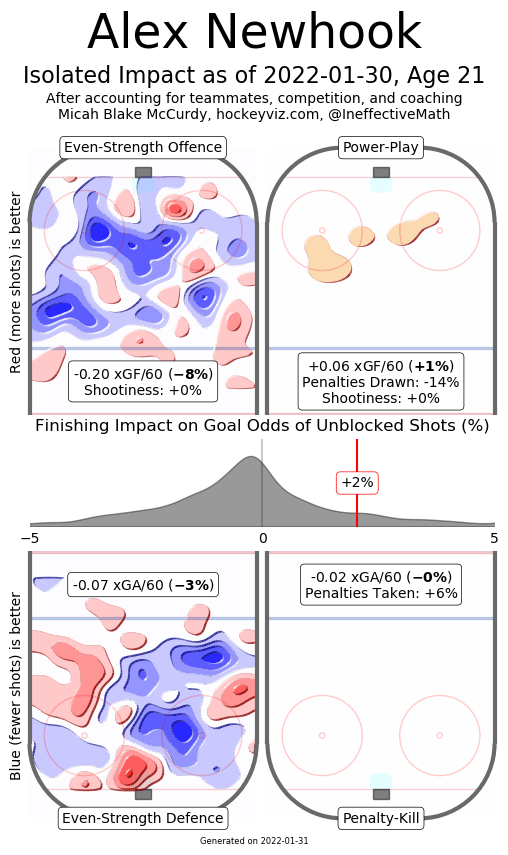
A reminder that on offense, negative is bad but on defense negative is good. Both models show that Newhook isn’t driving a lot of offense yet, but he’s cashing in on the chances he’s getting and his defense, while certainly not elite, is damn respectable for a rookie center.
On a lot of competitive teams, the organization prefers to put young centers on the wing to learn the NHL game first and then later move them to center after they’ve gotten more comfortable with the speed of the game. We saw this with Newhook in last year’s playoffs as he primarily played left wing.
While he’s occasionally moonlighted on the wing again this year, the majority of his time has come at the pivot, making the success he’s had all that more impressive. It also gives the Avalanche reason to feel comfortable when Kadri gets a huge offer in free agency that they can slot Newhook into Kadri’s current spot and still have a good player. That’s next year’s problem, though.
Right now, the focus is on what Newhook is currently doing, and that’s proving he belongs.
Digging into some of his underlying numbers, he’s treading water with a 50.22 CF%, 50.27 xGF%, and 51.78 SCF%. He’s getting beaten up in high-danger chances a bit at 43.80%, but the Avs are currently outscoring opponents 16-9 at 5v5 with Newhook on the ice.
All of that is solid. He’s not an All-Star or anything but he is an important contributor who just turned 21 last week and is starting to push for even more ice time.
The Bad
There haven’t been many areas of the Avs that have not gone well this year, but there are some things we can look to. For me, this section starts with Bowen Byram. Everything about his concussion issues continue to be disappointing and heartbreaking.
When on the ice, Byram was showing he could not only help the Avs but bring confidence and swagger to the blueline that elevated them from very good to undeniably the best defense in the NHL. He is a special talent and everyone is pulling for him to get healthy so he can continue his career (and, more important, normal life) without the lingering effects of concussions.
Moving on from Byram, we have to start with by far the worst area of the Avs.
The Penalty Kill
Sigh.
This unit has been through some things this season.
It started off the year poorly and it continued being bad despite some personnel changes and waiting for the goalies to come around and start playing better. Well, the goalies started to up their play and the PK was still atrocious.
Head coach Jared Bednar promised back on January 10 that there were major changes coming to the PK, both from a system and personnel perspective. At that point, the PK was sitting at 73.1%, good for 28th in the NHL.
That unit responded by going just 1-for-2 against Seattle’s 21st (at the time) ranked power play. The next night, it killed just 3-of-5 Nashville power plays, including the infamous overtime goal after the phantom too many men on ice penalty.
That was rock-bottom for Colorado’s PK, where it was 30th in the NHL at just a 72% success rate.
Since then, the numbers are pretty staggering.
Those first two games after promised changes, the Avs gave up three PPGs.
In the 11 games since then, they’ve given up just three PPGs, one of which was on a 5-on-3, in 35 opportunities. The 32-for-35 success rate is good for 91%.
Now, there’s an important caveat here. In those 11 games, the Avs played Arizona and Montreal, the two worst power plays in the NHL, four times and the Canadiens actually scored one of those three PPGs.
In fact, in that impressive 11-game stretch, the only teams that had PPs in the top half were Anaheim (10th) and Boston (4th). Against those two teams, the Avs killed seven-of-eight PPs, and the only goal scored was the 5-on-3 goal the Bruins scored.
Overall, that’s a mixed bag. The Avs PK certainly got better after the changes to the system, but it also got the benefit of playing against weaker competition. If you count those first two games after Bednar promised changes, the total numbers come to 36 kills in 42 attempts, good for an 85.7% success rate. That number would be good for the third-best PK in the NHL.
While the system changing was obviously important, the personnel has also changed some. Primary PK guys like Logan O’Connor and Tyson Jost are still doing their thing, but Val Nichushkin has gotten increased minutes and has been joined by Kadri and Newhook, who are eating into J.T. Compher’s role on the PK a little bit.
It will be interesting to see how the personnel continues developing, especially when Darren Helm, who has been a major letdown in all aspects so far this year, returns to health. Can they really justify putting Helm back in after such a poor season and the increased effectiveness in his absence?
On the season, Colorado’s PK has risen to 23rd in the NHL at 76.9%. While nice, there’s plenty of work left to do there. Here is Colorado’s PK in heat map form:
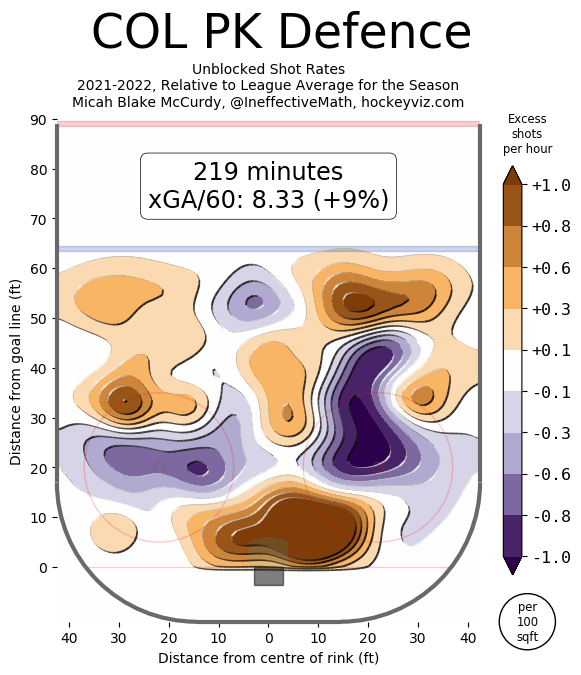
It will be interesting to compare this to whatever ends up being the final result at the end of the regular season. In case anyone was curious like I always am, this was last year’s PK, which finished 8th in the NHL at 83.1%:

Faceoffs
The only other area that I would label as “bad” right now is Colorado’s work in the faceoff circle.
Now, I’ve said this a million times but it comes up every. single. season. so I’ll repeat it once again: There is zero correlation between teams being good in the faceoff circle and winning games. In fact, there is little to suggest that faceoffs, on the whole, are all that important.
Where there is little doubt, however, is that faceoffs are important situationally. When you’re protecting a one-goal lead and have a defensive zone faceoff with the other team having already pulled its goalie, winning that faceoff could be the difference between protecting that lead and giving up the game-tying goal. It’s absolutely important.
There was much hand-wringing after Colorado beat Boston recently and the Bruins had a dominant faceoff night. I got multiple tweets expressing the sentiment of “Wow, glad the Avs pulled that out but they need help on faceoffs!”
I’m always amused by this because, you know, the Avs won that game despite only winning 42% of the faceoffs. On the season, Colorado is 28th in the NHL at 47.2%.
I don’t really care much about the team’s number overall, but I do think it is important they find some kind of solution for those important situations.
Right now, Colorado’s most successful lineup regulars are Gabe Landeskog (55.4%), J.T. Compher (50.7%), and Kadri (49.8%). If Mikhail Maltsev stays with the big club, he’s at least having an encouraging season in the dot at 57.9%.
Where my concern lies, and this is the ultimate nitpick of a hockey team, is they don’t have a right-handed solution for those draws. While Compher is right-handed, his current 50.7% mark is by far the highest of his career.
That is to say, I don’t have much confidence in his success rate staying there, and even if I did, Compher has had such a mediocre season that I’m not sure him being on the ice in that situation is a good thing because of all that happens after the faceoff is over, win or lose.
I don’t tend to think this is a huge deal, but min-maxing the roster is always part of a general manager’s goal in the run-up to the trade deadline and this is an area where the Avs could use a little bit of help (insert Ryan Carpenter and Luke Glendening speculation).
The Getting Better So Everyone Stop Panicking
There’s only one thing in this section and I want to make it quick because this article has already been obscenely long.
Goaltending
This is just going to be a lot stat dumps because saying too much else about goaltending usually ends up in me looking dumb.
The big thing I’ll note here is that the goaltending started off slowly but has gotten much better since Pavel Francouz returned to health. Darcy Kuemper also just had easily his best month as an Av and is trending upward in a big way.

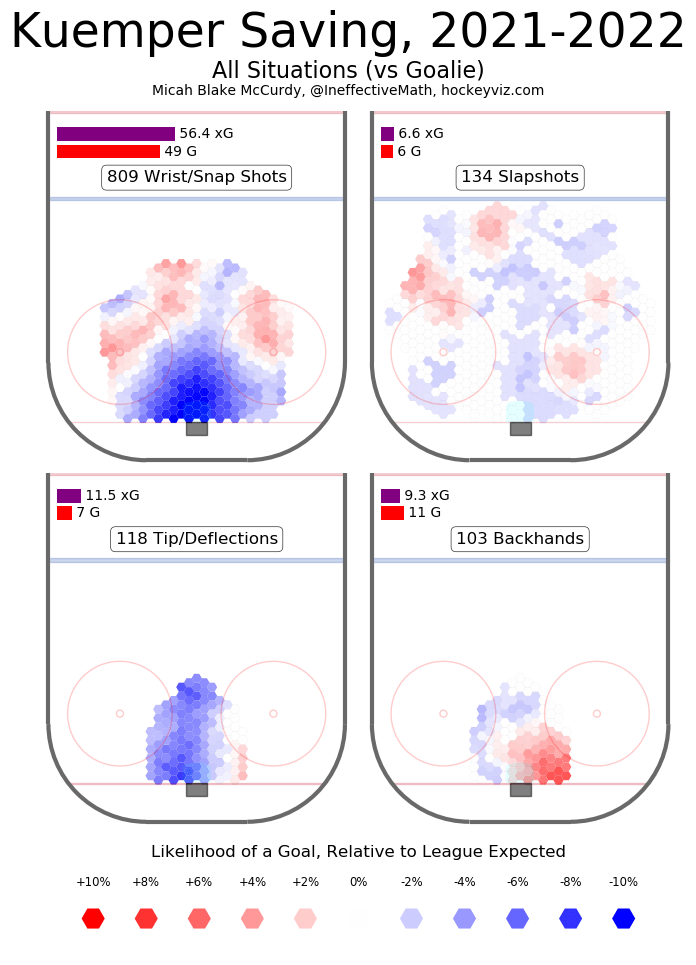

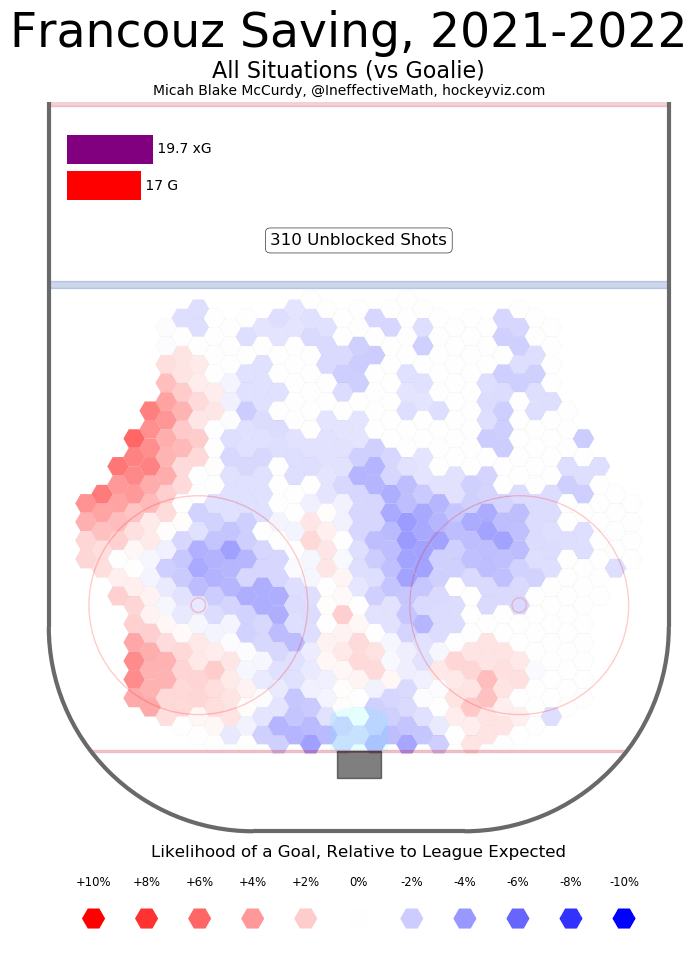

This gives you an idea of where each of Colorado’s two main goalies are having success or struggling. The goal is to have a higher xG than G. That means the goalies are stopping more shots than they are expected to based on the expected goals formula.
As noted above, it was a slow start for Kuemper but he has recently begun creeping into the top 15 of most goalie stats among starting goaltenders.
Francouz has done an excellent job stabilizing the position so that Kuemper isn’t having to overextend himself in the regular season and is making an early case that he should be a priority re-signing this summer.
The End
I never really know how to end these things so I’m adding a whole separate section so you know this is where you can stop skimming (I know you do it, it’s okay, we’re all human).
There are plenty of other things I could have put in the Good section (I probably could have done an entirely separate piece on what has gone well for the Avs this year on an individual AND team level) and a few other candidates for the Bad and Improving sections, but this piece is already really long and I expect plenty of you have stopped reading by now.
All of this is to say: This hockey team is very good. It isn’t without flaws, but the first half of the season it just completed is among the best in franchise history for a reason. This group has a chance to be special.
There’s a long way to go and what could be a scenery-changing deadline awaiting us, but things are looking pretty exciting right now for the Colorado Avalanche.
Comments
Share your thoughts
Join the conversation



